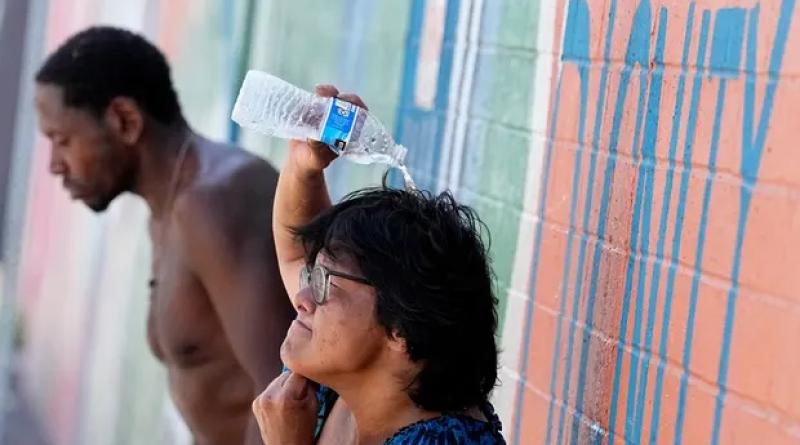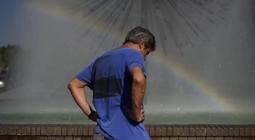‘Silent killer’: experts warn of record US deaths from extreme heat

The punishing heatwaves that have scorched much of the US could result in a record number of heat-related deaths this year, experts have warned, amid a spike in hospitalizations from collapsing workers.
Among those needing hospital treatment are heat-exhausted hikers and even people who have suffered severe burns from touching blistering concrete and asphalt.
Heat is the leading weather-related cause of mortalities in the US, outpacing deaths from hurricanes by a factor of eight to one, and this summer’s record-breaking temperatures, worsened by the human-caused climate crisis, have led to fears a new annual high death toll will be set in 2023.
“This year looks on pace to potentially break records, in terms of heat and heat mortalities,” said Gregory Wellenius, an expert in environmental health at Boston University School of Public Health.
“We are seeing the full spectrum of risks, from heat exhaustion to more injuries from dehydration to even new food or water borne illnesses because bacteria can replicate faster in warmer weather. My guess is that 2023 will prove to be one of the years with the most heat-related excess deaths on record in recent memory.”
States that have experienced some of the most drastic heatwaves this summer are already experiencing a surge in heat-related hospitalizations, according to Centers for Disease Control and Prevention (CDC) data. In the week ending 22 July, a group of western states including Arizona, California and Nevada had a rate of heat-related hospitalizations 51% above the average seen since 2018, while southern states including Texas and Louisiana had a 37% spike.
While many cities and states have put in place heat action plans, by setting up cooling centers and providing warnings to vulnerable people, such as the elderly, many people are still either underestimate the dangers posed by extreme heat or are placed in peril by their jobs or living conditions.
“There’s a reason heat is labeled a silent killer. People often don’t realize they are in trouble until things are progressing rapidly,” said Kristie Ebi, an epidemiologist at the University of Washington who specializes in climate effects.
“I would expect to see a spike in deaths this year. Everywhere is going to struggle with extreme heat and we just don’t have the level of preparedness we need.”
Although it will take several months for the summer’s death toll to be known, doctors have reported worrying effects from the withering heatwaves that have stretched across the US. This week more than 170 million Americans have been placed under heat alerts.
In Phoenix, Arizona, which has had a record 27 consecutive days above 110F (43C) days this month, there have been 25 heat-related deaths have been reported so far this year, with hospitalizations rising along with the mercury. The heat has been so extreme that every bed in the Arizona Burn Center has been filled, with one third of patients suffering burns after falling on to the scalding hot ground. Doctors have reported seeing people with third-degree burns on their feet from walking on asphaltIt has been a similarly perilous summer for those visiting America’s national parks, with a flurry of heat-related deaths, including a 14-year-old boy who died in Big Bend national park in Texas in 119F (48C) heat; a 57-year-old woman who died hiking at the Grand Canyon; and two elderly men who, separately, died in the withering heat of Death Valley national park, where the temperature hit a near-record 128F (53.3C) this month.
Those at particular risk from the heat are unhoused people, people who work outdoors, those without reliable air conditioning, elderly people, and those with existing medical conditions – about half of heat deaths are thought to be from heart attacks quickened by the high temperatures.
People living in concrete-dominated cities, particularly those in poorer neighborhoods that lack tree cover and other ameliorating greenery, are also at risk, with a report this week finding that the “urban heat island” effect can add about eight degrees to the temperatures felt in cities such as New York, Chicago, Houston and Los Angeles. In some places, even children’s playgrounds, with burning hot slides, have proved hazardous.
“Some of the most vulnerable people, such as the elderly, find it hard to move to cooling centers, which is a challenge,” said Wellenius.
If you live in an air-conditioned home and travel by an air-conditioned car to an air-conditioned office you will probably be OK if you’re smart, but many people don’t have that opportunity, if they are picking fruit in fields or working in construction.”
When this summer’s death toll is known, it will almost certainly be an undercount. Figures from the CDC show that the number of heat-related deaths has climbed in recent years, to more than 1,500 last year, with increasing numbers of local authorities and coroners prepared to designate heat as a cause of death. But research has shown the true figure is probably much higher, with Wellenius estimating at least 10,000 people a year die in the US from extreme heat.
This year could top this figure in reality, with states such as Florida and Texas enduring long spells of prolonged heat and high night-time temperatures that have denied people respite, placing extra strain on those vulnerable to extreme conditions. A recent study found that heatwaves in Europe last year, which could not have happened without climate change, caused more than 60,000 deaths.
Air conditioning is far more prevalent in the US than Europe, but many places in America are still not set up to deal with the sort of supercharged heat that has marked this summer, according to Ebi, even if public concern is rising – recent polling by Yale University found that seven in 10 Americans are now at least somewhat worried about extreme heat.
“There are heat action plans but people need to know what to do and there has been almost no research on how to communicate best to people, to change behavior,” said Ebi. “We need tiered early warnings to say, ‘If you’re in these groups you’re at risk, start preparing now.’ People still don’t see heat as a killer, so we need to help people get past our perceptions.”
On Thursday, Joe Biden announced new measures aimed at helping those exposed to extreme heat, as scientists confirmed that July is on track to be the hottest month ever recorded globally. This month has already experienced the hottest day, and hottest week, measured by modern instrumentation. The heatwaves roiling the northern hemisphere show “the era of global boiling has arrived”, according to the UN secretary general, António Guterres.
Some lawmakers in the US want more sweeping action to help deal with this onslaught. A group of Democrats have proposed a new bill to provide all US workers in high heat environments with mandatory paid, shaded breaks and are provided water, a stipulation that Greg Abbott, the Republican governor of Texas – which has endured scorching heat this summer – has outlawed.
“The climate crisis has made scorching temperatures, incidents of workers collapsing and deaths all too common,” said Raúl Grijalva, a Democratic congressman from Arizona. “We must act now and decisively to protect people.”
cover photo:People try to cool off in downtown Phoenix in July. Photograph: Matt York/AP





